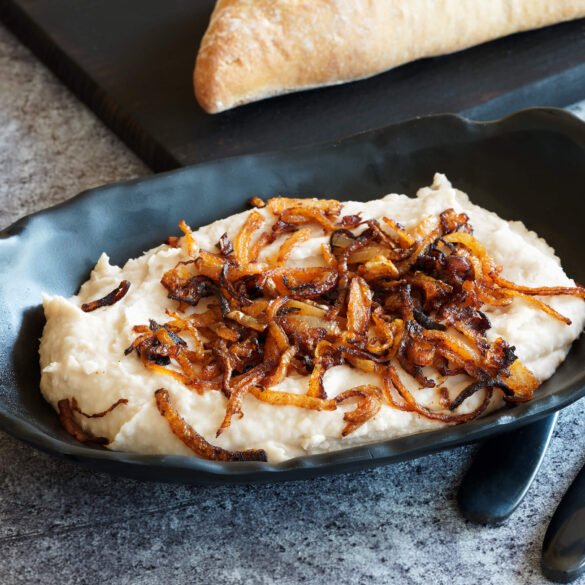If you ever visit Romania, you will quickly discover that appetizers (gustări) are not just a prelude to the main meal, but a ritual in themselves. Platters are generously filled with cold cuts, assorted cheeses, pickles, and – perhaps most importantly – a selection of homemade spreads. Among them, three classics stand out: the smoky eggplant spread (salată de vinete), the colorful vegetable spread (zacuscă), and the creamy white bean dip known as fasole bătută.
This humble yet flavorful dip is one of the staples of Romanian cuisine. It is particularly common during fasting periods (post), when meat, dairy, and eggs are avoided. In those times, spreads like fasole bătută are not only nourishing but also deeply comforting, served with caramelized onions and fresh bread.
What is Fasole Bătută?
The name literally means “beaten beans.” Traditionally, dried beans are soaked overnight, boiled until tender, and then mashed into a creamy paste. Garlic and sunflower oil are often added for flavor and smoothness, while the dish is crowned with a generous topping of caramelized onions. It is this onion garnish that transforms the beans into something truly irresistible, adding sweetness and depth to what might otherwise be a very simple spread.
In my case, I chose the “busy person’s version” of this recipe: instead of boiling dried beans for hours, I used canned white beans, already cooked. The only thing I actually turned on the stove for was the onion topping – because let’s face it, fasole bătută without caramelized onions would be unthinkable. Using precooked beans makes the whole process quick and easy, so you can enjoy this traditional Romanian dish even on a busy weeknight.
Flavor… and a Word of Caution
As much as we love fasole bătută, it does come with a little disclaimer. Beans, as everyone knows, are a gas-generating powerhouse. They’re packed with protein and fiber, which makes them incredibly healthy, but also notorious for creating less-than-subtle aftereffects.
To make things even more interesting, the classic topping of caramelized onions and the garlic doesn’t just add flavor – they also contribute to… uhm… the “fragrance.” Put simply, this is a dish that tastes amazing but won’t win you any points in the socially discreet department.
So, a fair warning: fasole bătută is not the best choice before a date or an important interview. It’s hearty, comforting, and absolutely delicious, but perhaps best enjoyed when you’re among friends or family.
ad

Ingredients
- two cans of boiled white beans, 450 grams each (cannelini)
- one yellow onion
- 2-3 cloves of garlic
- 2-3 tablespoons sunflower oil
- 1 tablespoon tomato paste
- 1/2 teaspoon of sweet paprika
- salt, to taste
Instructions
Drain the beans in a colander to remove the canning liquid, then rinse well under running water.
Place the beans in a food processor together with the garlic cloves and oil. Blend until smooth. If the mixture is too thick, add water one tablespoon at a time until you reach the desired consistency.
Peel the onion and cut it in half, then slice it into half-rings about 3–4 mm thick. Heat the oil in a pan, add the onion, and cook over medium heat for 8–10 minutes, stirring occasionally, until golden. Towards the end, stir in the tomato paste and sweet paprika, and cook for another 1–2 minutes. Do not overcook, or it will become bitter. Remove from heat and let cool slightly.
Top the bean purée with the onion mixture and serve.
Notes
Some versions of this recipe suggest reserving a small amount of the liquid from the can and using it instead of water. While this can give a more intense flavor, I personally never use this method. The liquid in which the beans were stored contains oligosaccharides, which contribute to gas production.
Use only white beans. Otherwise, the bean dip will have an odd color.
Choose sunflower oil or another neutral-tasting oil. Never use olive oil.

